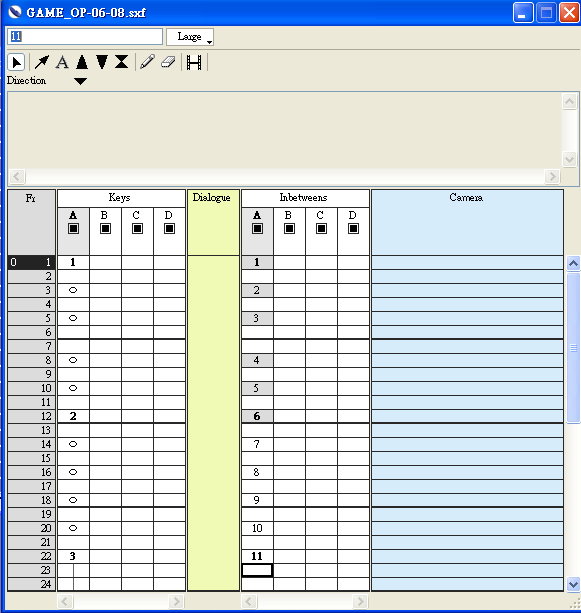I realize this tool was developed specifically for Japanese workflow , but how easy would it be to modify the timesheet (exposure sheet) script to make it replicate the arrangement of a "Western" style x-sheet ?
Could we have a version that has:
1.) Continuous frame count running down the left side starting at 1:
1
2
3
4
5
6
7
8
9
10
11
12
13
14
15
etc.
OR if the frame count is shown advancing "ON 2's" please start it at frame 1 and advance
like this:
1
|
3
|
5
|
7
|
9
|
11
|
etc.
2.) please have the spacing of the columns be slightly wider , and the
order of the columns (layers) reading from left - to - right , so for example , in the Timeline if I have six layers like this:
OL (overlay)
Anim-A
Anim-B
Anim-C
Anim-D
BG (background)
the timesheet/x-sheet will show them in this order, reading from left-to-right:
OL -
A -
B -
C -
D -
BG
As it is now the ordering of the layers on the TVPaint timesheet is the opposite order, reading from right- to - left . I'm really not sure why that would be the case ? In software used by many Japanese studios in the past (such as RETAS or TOONZ ) the X-sheets are shown with the same layout as a standard Western X-sheet, with layers ordered from left-to-right. For example, here is the RETAS X-sheet , which as the continuous frame count at the left starting from frame 1 , and has the layers ordered from left-to-right: A - B - C- D :

And indeed in some ways the TVPaint timesheet seems intended to replicate the layout of the RETAS X-sheet ... but why is the ordering of the layers on the TVPaint timesheet reversed from the way the layers are ordered on timeline when the timesheet is rendered ? It's confusing (to me).
Also, the overall layout of the timesheet seems cramped and not cleanly rendered for maximum readability. The font size used for "Dialog" and "Camera" is too large and those words are crammed into a space that is too small to contain them. Dialog could be abbreviated to "Dial." and Camera could be abbreviated to "Cam." The font size used to label the animation columns is also too large for the space allowed.
3.) For my purposes it would be better to see the sheet rendered with the actual drawing numbers placed frame by frame the columns rather than the X's which denote how many frames a drawing is exposed . (see below) However, I realize this may not be a simple thing to do without some major re-writing of the script , so at the least if a version could be written which shows the layers arranged from left-to-right that would be appreciated.
[click to view larger]
The cramped spacing of the sheet gets worse if the number of layers increases , as in the following example with 10 layers : Overlay (OL) - A - B - C- D - E- F- G - H - Background (BG).
[click to view larger]
On a standard Western exposure sheet , an "X" on a frame usually denotes a
blank layer or blank frame. So , let's say I have an animation layer that starts at frame 1 , but it is blank for 6 frames before the character starts to enter the scene at frame 13 :
on the timesheet/x-sheet there will be an X at frame 1 - extended through - frame -6 then at frame 7 the drawing numbers start , reflecting the actual timing of the animation:
X
|
|
|
|
|
7
|
9
|
11
|
13
|
15
|
17
|
19
20
21
22
23
24
25
|
27
|
29
|
31
|
etc.
(it would render the numbers on the sheet to show the exposure of drawings 'ON 1's" as continuous frame count , as above with section 19, 20, 21, 22, 23, 24 , and drawings exposed "ON 2's" (or held for longer ) would have a vertical line extending from the number until the next drawing number , as shown above with section 7, 9 , 11, 13 , 15, 17 , and 25 , 27, 29, 31 . )
But if this is not possible to render the sheet showing the actual drawing numbers, then the X's method currently employed would be usable for me, if the layers read from left-to-right and the layout of the columns are slightly wider and the font sizes not so large , to enhance the readability of the sheet. Also I would prefer a continuous frame count starting at frame 1.
-----
EDIT: I've gone back to review
Thierry's earlier post about how to use it and find that I skipped over some important parts , which is resulting in my not getting the results expected . Here are two important steps :
1.) Instances must be named and KEYS assigned an Image Mark color .
2.) after completing the INBETWEENS the inbetween frames must also be assigned an Image Mark color .
I'll elaborate in a later post.
.

